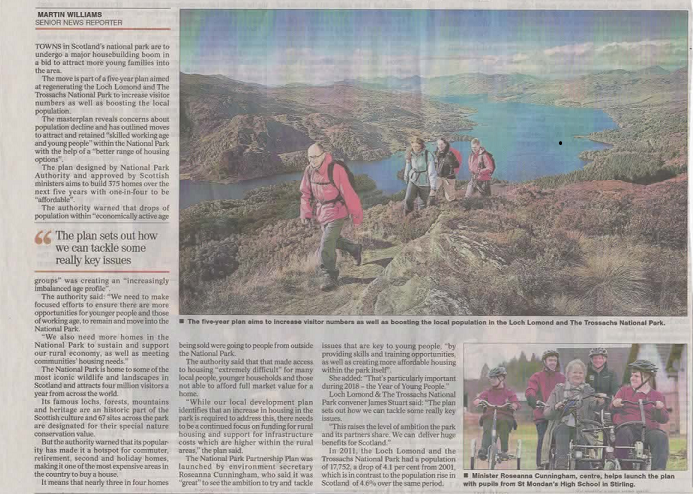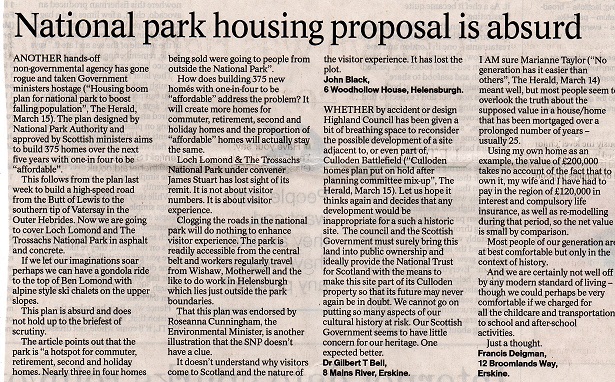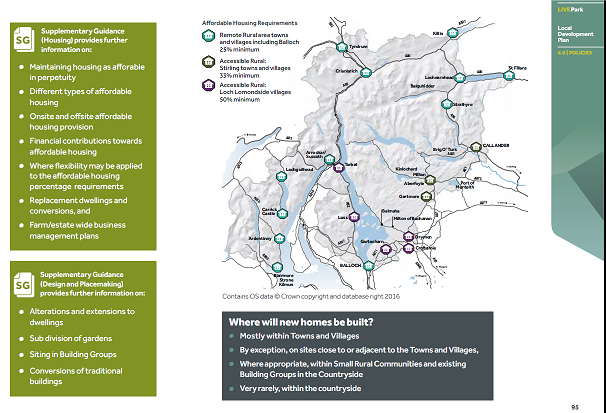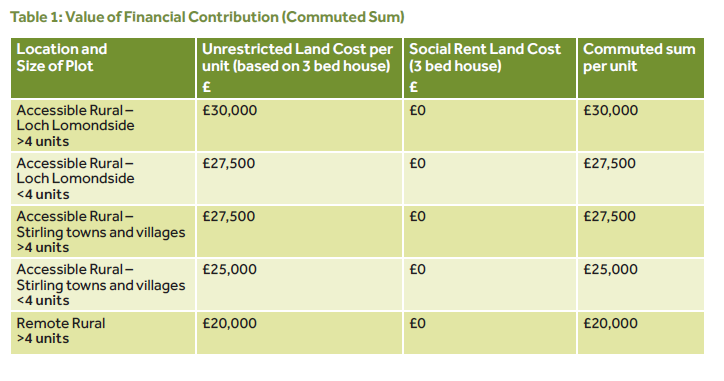
 The day of my post about the Loch Lomond and Trossachs National Park Authority becoming a camping management authority (see here), the article above appeared in the Herald. Proof, if you want, that what I said is not the whole story and a reminder – if one is needed after the Cononish gold mine decision – that the LLTNPA does continue to operate as a Planning Authority. What both its visitor management and planning functions share in common, however, is that both favour the rich over the poor and development interests over conservation.
The day of my post about the Loch Lomond and Trossachs National Park Authority becoming a camping management authority (see here), the article above appeared in the Herald. Proof, if you want, that what I said is not the whole story and a reminder – if one is needed after the Cononish gold mine decision – that the LLTNPA does continue to operate as a Planning Authority. What both its visitor management and planning functions share in common, however, is that both favour the rich over the poor and development interests over conservation.
Judging by the article, at the launch of the National Park Partnership Plan (NPPP) which the Board agreed in December last year (see here), the Minister, Roseanna Cunningham, made not a mention of conservation which is supposed to be the primary purpose of our National Parks. Indeed, the caption beneath the recycled photo from the LLTNPA website used in the article as it appears there reads: “We do many things, and we have many aims – but at the heart of it is conservation”. Now one could understand why Roseanna Cunningham avoided mentioning visitor management, given the camping byelaw disaster. Someone though should have asked her about how the claim in the caption used in the article that the LLTNPA wants to increase visitor numbers fits with it’s claim that there are too many campers – the answer is you need to be the right type of visitor with plenty of money in your pocket. But not to mention conservation? Confirmation that the LLTNPA is not planning to deliver a single worthwhile conservation initiative over the next five years?
While housing is a very important issue in National Parks, the focus on housing at the NPPP launch was a dreary recycling of old news which is more important for what it does not say than what it does. First up, the housing target of 375 homes was basically set by the Scottish Government – so here is the Scottish Government using the NPPP to announce something it decided some time ago. Talk about vacuous news.

The second thing that wasn’t said is that the housing crisis in the National Park has been exacerbated by the LLTNPA which a number of years ago decided to relax local occupancy conditions on new housing. Back in 1965 a local occupancy requirement was introduced to protect the south Loch Lomond villages of Tarbet, Luss, Gartocharn, and Croftamie in Dumbartonshire and was subsequently extended to include Drymen in Stirlingshire. This restricted the granting of planning permission and subsequent sales of houses to local people and a Section 75 agreement ensured this went on in perpetuity. What this did was to protect the areas of the National Park closest to urban conurbations from housing developers and to limit the number of holiday homes. While the occupancy condition may have been unduly restrictive – it made it very difficult for people with jobs in the National Park boundary to move in with the result that many people commuted from outside – it also sheltered the National Park from the housing market and kept housing prices relatively low. That has all changed since the LLTNPA lifted the occupancy conditions from most types of housing development (its still in place for farms etc which allows landowners to continue to build new tied houses).
The LLTNPA’s response to the growing housing disaster has again been conditioned by the Scottish Government and has been to require a certain percentage of housing to be affordable – “in perpetuity”. Interestingly the article states 25% of housing in the National Park will be affordable – this is the official Scottish Government target – when the LLTNPA Local Development Plan says otherwise:

One wonders therefore if the LLTNPA targets for affordable housing have now been abandoned?
While outwardly the LLTNPA targets for affordable housing look more impressive than those in the Cairngorms National Park Authority (25% except 35% in Ballater and Braemar, and to 45% in
Aviemore and Blair Atholl) all is not what it seems because the LLTNPA will allow a Financial Contrribution, also known as a Commuted Sum, to be made instead of these targets:
We accept that in some instances that funding may not be available or some proposals such as conversions do not lend themselves to on-site delivery and in these instances we may consider taking a financial contribution. The financial contribution will be used to provide affordable housing
elsewhere in the area.
While this would dilute the overall proportion of affordable housing provided (because if you are building 4 houses and provided a commuted sum for a further house to be built elsewhere, you have 5 houses in total and the affordable proportion has become 20%) the real problem is the small size of the Commuted Sums:

So, if you are a developer and want to build four “luxury” – developer’s houses are always luxury – houses for say £400k each it will only cost you £20-30k extra to build a fourth profitable luxury house instead of something affordable – whatever that means! In my view therefore the Park’s policy is extremely weak, exercises very little control over the open market and will be totally dependant on rural housing associations and other social housing providers to meet its targets. They still fall far short of the level of social housing that is needed in the Natioonal (as I demonstrated for Strathfillan and the numbers of people who will need housing if the Cononish gold mine ever goes ahead (see here.).
So what are the solutions to the housing crisis in our National Parks?
Thankfully, there is a lot of really good work going on at present to develop alternatives to the current housing market, which benefits the rich and developers, and makes it impossible for all the people working in the tourist industry and for landowners in our National Parks ever to be able to afford their own house.
Politically, the Green MSP Andy Wightman has been driving this – and the Greens have political clout as the SNP are dependent on them to stay in power and his blog piece last week was nicely timed for the launch of the NPPP (see here).
As significant however the Scottish Government’s own agency, the Land Commission, has been paying a great deal of attention to the relationship between Land and Housing and an excellent blog was published last week by Professor David Adams on Public Interest Development ((see here) – it also appeared in the Herald). This explained how housing development used to be done by public authorities and suggested that only by doing so again will we address the housing crisis. I recommend it and it should be required reading for National Park Planning Committee Members and Planning staff. There is even time to incorporate this work and approach into the new Cairngorms National Park Authority Local Development Plan.
it’s interesting that the Scottish Government, H&IE, and the Highlands Council are happily developing relationships with organisations such as the Highlands Small Communities Housing Trust to come up with diverse ways to help people find places to live in the Highlands – from self build and rent-to-buy, to purchase of affordable houses. What’s particularly interesting is that whilst the Cairngorms National Park seems to have a number of such projects on the go, I can’t find any linked to the Loch Lomond National Park. So, as you imply, this isn’t because there isn’t funding or ideas – or the will to make these things happen – but because the LLNPA just doesn’t seem to care. This might be because of the interests and motivations of its current leadership team – but surely a National Park has a responsibility to us all to implement it’s legal responsibilities appropriately (not just one or two of them). This comes back to your common theme – who polices the Park Authorities, and why does that “policing” appear to be so selective. Could it be as simple as political bias? Or incompetence? Either way there’s clearly an issue.
I note that the five locally elected members of the LLTNPA are up for re-election in July this year – and that of the six members appointed by the Scottish Government, one position is currently vacant. Nick – perhaps you could consider standing for one of these? You might only be one of 17, but I’m sure you’d be an asset 🙂
Public appointments in Scotland are managed here http://www.appointed-for-scotland.org/ – but I can’t see the LLTNPA vacancy advertised, which seems a little odd.
If you search that web site for LLTNPA appointment news there hasn’t been anything since 2015 when the current lot of Minister-appointed members were chosen – including the Convener (James Stuart). This is how it is reported:
“Major James Stuart has had an interest in the National Park for many years. In a personal capacity, he has sailed and raced on the Lochs in the park and has also enjoyed walking and running within the hills and mountains. In a professional context he has worked with the Authority whilst leading two sports governing bodies over recent years (RYA Scotland and Scottish Equestrian Association) and also through being a member of the national tourism strategy (Tourism Scotland 2020) strategic leadership group.
He hopes that his contemporary understanding of sport, recreation, outdoor sports, governance and his strategic engagement with the National Tourism Strategy equip him suitably to support and inform the board. He is currently the Managing Director of Edinburgh Pharmaceutical Processes, a family owned Contract Research Organisation.”
History has shown that he’s pretty much done what he promised, and focussed on tourism. Although you have to be quite well off (a retired Major, perhaps) to take part in sailing and racing on the Lochs.